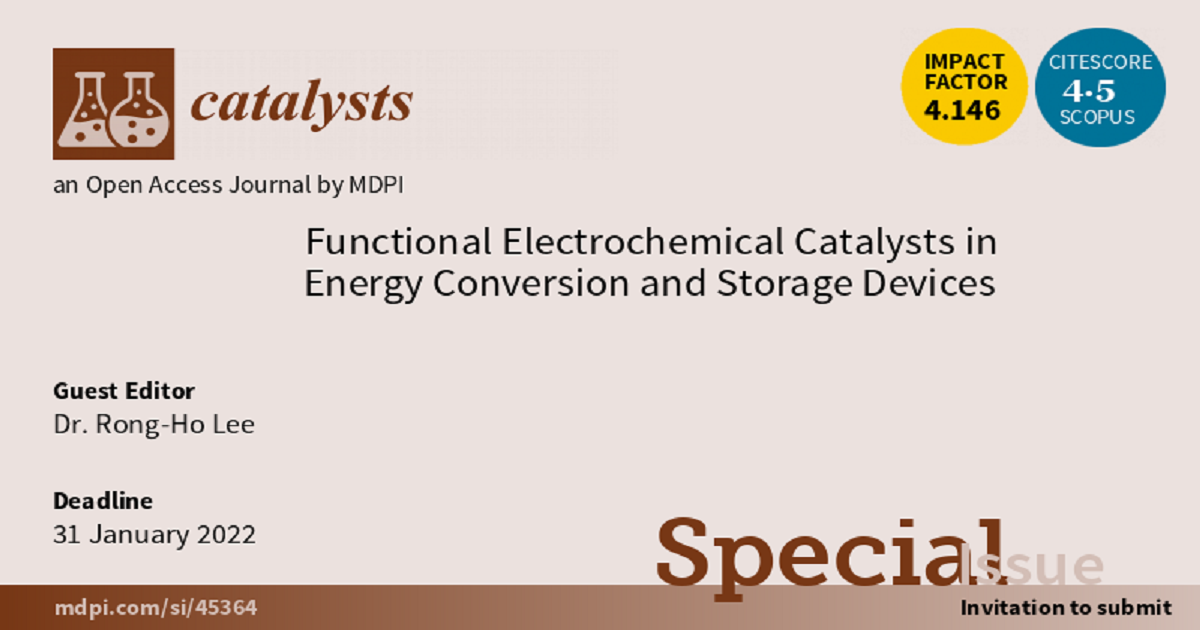Functional Electrochemical Catalysts in Energy Conversion and Storage Devices
A special issue of Catalysts (ISSN 2073-4344). This special issue belongs to the section "Electrocatalysis".
Deadline for manuscript submissions: closed (31 January 2022) | Viewed by 12484

Special Issue Editor
Interests: polymer solar cells; pervoskite solar cells; supercapacitors; energy conversion and storage materials and devices; electrocatalystic of transion metal oxides; cellulose derivatives for EO applications; 3D printing; sensors for pressure and strain
Special Issues, Collections and Topics in MDPI journals
Special Issue Information
Dear Colleagues,
Electrocatalysts may participate in electrochemical reactions to increase the oxidation and the reduction reaction rate, which is a specific form of catalysts that works on the electrode surfaces or in the electrode. Electrocatalysts can accelerate the transfer of electrons between the electrode and reactants, and/or facilitate an intermediate chemical transformation. The electrocatalytic activities of electrode catalysts are generally dependent on the particle size, particle size distribution, morphology of the catalyst, and catalyst surface composition. Activity, cost, durability, and stability are important issues for the development of electrocatalysts. In addition, good catalyst support with high surface area for catalytic dispersion, good chemical stability in various electrolytes, and fine electronic conductivity also play critical roles in facilitating catalytic effects. Electrocatalysts are usually incorporated into both the anode and cathode of photoenergy conversion solar cells and energy storage devices. Therefore, this Special Issue “Functional Electrochemical Catalysts in Energy Conversion and Storage Applications” covers synthesis, characterization, nanostructure, and electrochemical catalytic activity analysis of various electrochemical catalysts for photoenergy conversion and energy storage applications. For example, the electrochemical catalytic effects of metal oxide, metal nitride, and metal sulfide on the electrode of dye sensitized solar cells, organic solar cells, perovskite solar cells, electrochemical cells, supercapacitors, fuel cells, polymer lithium batteries, photoenergy conversion devices, and energy storage devices are of interest. Both reviews and original papers are welcome.
Dr. Rong-Ho Lee
Guest Editor
Manuscript Submission Information
Manuscripts should be submitted online at www.mdpi.com by registering and logging in to this website. Once you are registered, click here to go to the submission form. Manuscripts can be submitted until the deadline. All submissions that pass pre-check are peer-reviewed. Accepted papers will be published continuously in the journal (as soon as accepted) and will be listed together on the special issue website. Research articles, review articles as well as short communications are invited. For planned papers, a title and short abstract (about 100 words) can be sent to the Editorial Office for announcement on this website.
Submitted manuscripts should not have been published previously, nor be under consideration for publication elsewhere (except conference proceedings papers). All manuscripts are thoroughly refereed through a single-blind peer-review process. A guide for authors and other relevant information for submission of manuscripts is available on the Instructions for Authors page. Catalysts is an international peer-reviewed open access monthly journal published by MDPI.
Please visit the Instructions for Authors page before submitting a manuscript. The Article Processing Charge (APC) for publication in this open access journal is 2200 CHF (Swiss Francs). Submitted papers should be well formatted and use good English. Authors may use MDPI's English editing service prior to publication or during author revisions.
Keywords
- electrochemical catalysts
- dye sensitized solar cell
- organic solar cell
- perovskite solar cell
- electrochemical cell
- supercapacitor
- fuel cell
- battery
- photoenergy conversion
- energy storage
Benefits of Publishing in a Special Issue
- Ease of navigation: Grouping papers by topic helps scholars navigate broad scope journals more efficiently.
- Greater discoverability: Special Issues support the reach and impact of scientific research. Articles in Special Issues are more discoverable and cited more frequently.
- Expansion of research network: Special Issues facilitate connections among authors, fostering scientific collaborations.
- External promotion: Articles in Special Issues are often promoted through the journal's social media, increasing their visibility.
- e-Book format: Special Issues with more than 10 articles can be published as dedicated e-books, ensuring wide and rapid dissemination.
Further information on MDPI's Special Issue polices can be found here.





